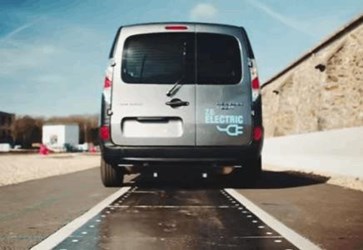Qualcomm Wireless Technology Charges Electric Vehicles In Motion
By Jof Enriquez,
Follow me on Twitter @jofenriq

Qualcomm has demonstrated a dynamic electric vehicle charging (DEVC) wireless technology using embedded road pads that charge electric vehicles up to 20 kilowatts while moving at highway speeds, eliminating the need for electric cars to stop at a charging station.
Based on the Qualcomm Halo wireless electric vehicle charging technology (WEVC), the DEVC system charged two Renault Kangoo vehicles as they drove over a 100-meter, custom-built FABRIC test track in Versailles, France. The same vehicles, traveling in both directions and in reverse on the same track, were able to be charged simultaneously, announced Qualcomm.
Better known for providing chips to smartphone makers, Qualcomm is pushing into automotive technology and the Internet of Things to counter a slowdown in the traditional chipset market, as well as tap into a burgeoning electric vehicle market.
The company is competing with other technology firms, car manufacturers, and startups in trying to leverage wireless charging, also known as inductive charging, to make electric vehicles more viable and attractive to consumers wary of so-called 'range anxiety' -- the worry that the electric vehicle will run out of power before reaching the destination or charging stations which are still few and far between outside major urban areas.
Inductive charging sets up an alternating electromagnetic field, then an induction coil in a smaller device harvests power from it, explains Technology Review. Qualcomm's track has charging pads embedded on the road surface and receiving parts onboard the two Renault Kangoo vehicles picks up the charge.
"If a vehicle can be charged as it goes, it doesn’t need to pull up at the side of the road be plugged into an electrical supply; it can, in theory, run indefinitely," explains Technology Review. A major drawback, however, is requiring a continuous line of electromagnets along a road network, which likely would require costly and extensive reconstruction.
Qualcomm plans to hold further tests at the FABRIC (FeAsiBility analysis and development of on-Road chargIng solutions for future electriC vehicles) facility through December 2017. The €9 million FABRIC project is mostly funded by the European Commission, and its participants include 25 organizations from nine European countries, including car makers, suppliers, and automotive research groups.
"I am immensely proud of what we have achieved," said Steve Pazol, VP and GM, wireless charging, Qualcomm Incorporated. "The combination of a global team of expert engineers and Qualcomm Halo technology, which covers all aspects of WEVC systems, irrespective of the magnetics used, has enabled us to really push the boundaries of the possible and outline our vision for future urban mobility."
